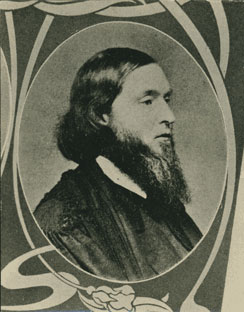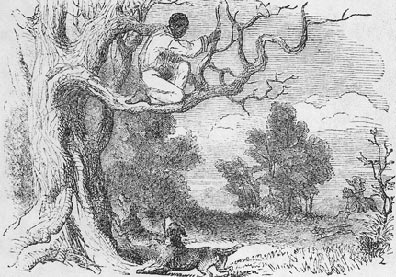Burlington
Fugitives were sent to Lucius H. Bigelow in Burlington by train from Rutland, Vermont. Bigelow had two close associates, a businessman named Weir and the Unitarian minister, Joshua Young. When slave hunters were in Burlington, fugitives would leave the train before reaching the city and walk to Bigelow's house on Church Street. It was a large home, and he had a separate wing which servants were not permitted to enter. Bigelow personally nursed fugitives who were too ill to continue on their journey. Sometimes, Rev. Young sheltered fugitives in the loft of his barn, but, in most cases, they were cared for in Bigelow's home.

Rev. Joshua Young
One Saturday night, Rev. Young was awakened by Bigelow's rapping on his window. Young got up and opened the window, and Bigelow told him, "dress yourself and come out here." Bigelow took Young to his shed where he was keeping six fugitives. He could not keep them in his home that night, so they were taken to Weir's office. The runaways were "so worn with travel and fear they sank on the floor asleep." Bigelow and Weir spent the night bathing their feet, which were cut, bruised and caked with dust and blood, and "oofed at every step." But "the slaves never stirred in their sleep, so worn were they." Young procured food for them, and he and Weir obtained new clothing for them by breaking into a friends store. The rags they had "scarcely covered them." (Young and Weir later reimbursed their friend for the things they had taken.) The fugitives were from the same Virginia plantation. They included three field hands, the butler, coachman and a house servant. They had "walked the greater part of the way" to New York, and then taken a train for Rutland. From Rutland they had walked to Burlington "at one stretch, with no food."
All were kept in Weir's inner office all day Sunday. That night, Weir and Bigelow drove them by carriage to St. Albans, where they put them on the train for Montreal.
One 40-year old woman who came to Bigelow walked all the way from Tennessee. It took her several months, and she arrived in Burlington in the "dead of winter, walking from Rutland on the railroad." She was so ill and her feet so frozen, Bigelow kept her in his home for three weeks before sending her to Canada. She sent him notice of her safe arrival.
A man who was a waiter in a hotel and who had been living in Burlington long enough to buy a house and start a family, saw his former master at a dining table. He went immediately to Bigelow, who quickly drove him out of town and paid his fare to Canada. Bigelow returned to tell the man's wife and children what had happened. Bigelow took charge of matters, sold the man's house and, sent his wife with the proceeds to Montreal where the family was reunited.
Some fugitives were sent from Burlington on steamers to Rouses Point, secreted by friendly mates or officers. It is likely that one of the crew members who assisted fugitives was Tony Anthony, a black man who was a cook in Burlington hotels and on Lake Champlain steamboats. Mr. Anthony's son, Abial, remembered seeing fugitives "in the morning and often again in the evening, but they would be gone the next morning." Most of the runaways were young and from Virginia, but sometimes there would be one from New Orleans who had had a very hard time getting though. Some had been pursued by bloodhounds.

Sources:
Rev. Joshua Young image, Ohio Historical Society and Special Collections Bailey Howe Library University of Vermont.
The Underground Railroad in Vermont, vol. 1, MIC 192 Wilbur H. Siebert Collection (1840-1954) Microfilm Edition] (Columbus: Ohio Historical Society), reel 15.
Swanton
The Hon. William L. Sowles was the "chief manager of Underground Railroad traffic" in Swanton, which was less than ten miles north of St. Albans. Sowles sent freedom seekers eleven miles northeast to Franklin, which was "on the very border of Canada." Charles Felton was the leading agent in Franklin. He may have forwarded fugitives to Phillipsburg, in Canada East.

The Hon. William L. Sowles house,
as it looks today
In 1927, Samuel Boyd of Glens Falls, Warren County, New York, recalled how his father took two fugitive slaves to Swanton:
Many of our prominent citizens knew all the ropes and helped pull them. A personal item here will explain something of the system. I went out one winter morning to feed our cow. When I went up to the hayloft I saw pushed out from under the hay a big pair of shoes and heard a powerful snore. To say I was frightened is putting it mildly. I rushed into the house and told father what I had seen and heard. I was straightaway set in a chair with the admonition not to say a word about it and not leave the room all day. Twice during the day I saw father take out food in a pail to the barn, and as evening darkened he drove in the yard with a long sleigh loaded with bags, opened the barn door and drove in. Then he came out, the load apparently the same. He was gone until the third day at night, when he came home. Meantime, I was told all about it, and so impressed that I never mentioned it until slavery was no more. Father had two slaves in that load, whom he delivered to a Center in Swanton, VT and the next trip landed them over the border into Canada.
Swanton was favorably located near Lake Champlain and Canada. The lake was less than ten miles to the west, and in 1849, the Vermont and Canada Railway arrived.
There have been several fictionalized accounts of Vermont's UGRR history:
Neighbor Jackwood is a play by J. T. Trowbridge (Boston: Lothrop, Lee & Shepard Co., 1856). It was a very popular stage production. Click here to see Neighbor Jackwood.
Out of Bondage and Other Stories (Rutland, Vermont: Charles E. Tuttle, 1936), was written by Rowland E. Robinson (UGRR stationmaster Rowland T. Robinson's son).
The Black Bonnet is a children's book by Louella Bryant (Shelburne, Vermont: New England Press, 1996). Two sisters escape from Virginia to Vermont. One makes it all the way to Montreal. Joshua Young, Lucius Bigelow and Jeremiah Boggs appear in this book, but Jeremiah's name has been changed to "Franklin."
Sources:
Aldis Brainerd to W.H. Siebert, October 21, 1895; Joshua Young, D.D. to Wilbur H. Siebert, April 21, 1893; Theron S. Dean to Wilbur H. Siebert, Feb. 19, 1936, [The Underground Railroad in Vermont, vol. 1, MIC 192 Wilbur H. Siebert Collection (1840-1954) Microfilm Edition] (Columbus: Ohio Historical Society), reel 15.
Dr. David Sherwood Kellogg Collection, 70.8, Box 5, Folder 1: Recollections Told by Various Persons, June 3, 1887: Stephen Keese Smith (Battle of Plattsburgh and the Underground Railroad). Special Collections, Benjamin F. Feinberg Library, State University of New York at Plattsburgh
Oliver Johnson to Rowland T. Robinson, Jan. 27, 1837 and and Oliver Johnson to Rowland T. Robinson, April 3, 1837. Letters of the Underground Railroad (Ferrisburgh, Vermont: Rokeby Museum, 2000), 6.
Samuel Boyd, "In the Days of Old Glens Falls" (1927).
Wilbur H. Siebert, Vermont's Anti-Slavery and Underground Railroad Record with a Map and Illustrations (Columbus, Ohio: The Spahr and Glenn Co., 1937) Reprinted in Canada by Tony O'Connor Vt. Civil War Enterprises.
William L. Sowles House photo by Robert Pelletier.






